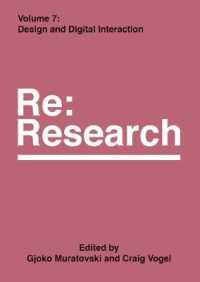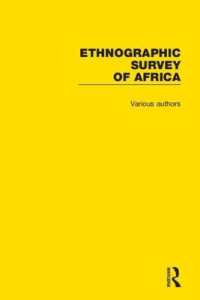- ホーム
- > 洋書
- > 英文書
- > Nature / Ecology
Full Description
This specially curated collection features four reviews of current and key research on supporting cereal production in sub-Saharan Africa.
The first chapter reviews how research and development can support smallholder wheat farmers through improving access to resources and services. The chapter considers current obstacles faced by smallholder farmers, including biophysical limitations such as climatic issues, as well as socio-economic limitations such as land availability.
The second chapter assesses the importance of increasing the adoption rate of improved maize technologies within smallholder farming households across Africa. The chapter discusses the economic and institutional barriers inhibiting adoption, as well as farmer attitudes to innovation.
The third chapter describes the effect of poor soil fertility, drought and weeds on maize yields in West Africa. The chapter considers strategies for mitigating these constraints, including nutrient management using fertilizers, weed management and resistant varieties of maize.
The final chapter discusses phosphorus scarcity in areas of West Africa and details the need to improve sorghum breeding to enhance the crop's tolerance to low-phosphorus soil conditions.
Contents
Chapter 1 - Supporting smallholders in improving wheat cultivation: Tinashe Chiurugwi, Simon Kerr, Ian Midgley, and Lesley Boyd, National Institute of Agricultural Botany (NIAB), UK; Johnson Kamwaga, Food Crops Research Centre - Njoro, Kenya; Peter Njau, Highlands Agri-consult Services Ltd, Kenya; Terry Van Gevelt, University of Cambridge, UK; Claudia Canales and Max Marcheselli, The Malaysian Centre for Commonwealth Studies (MCSC) and the Cambridge Malaysian Education and Development Trust (CMEDT), UK; 1 Introduction: smallholder wheat cultivation2 Limitations to smallholder wheat cultivation3 How research addresses limitations to smallholder wheat cultivation4 Case study: Agri-transfer5 Future trends6 Where to look for further information7 References
Chapter 2 - Constraints in adopting improved technologies for maize cultivation: the case of Africa: T. Abdoulaye, The International Institute of Tropical Agriculture (IITA), Nigeria; A. S. Bamire and A. A. Akinola, Obafemi Awolowo University, Nigeria; and A. Alene, A. Menkir and V. Manyong, The International Institute of Tropical Agriculture (IITA), Nigeria; 1 Introduction2 Understanding farmers' decisions on improved technology adoption: the adoption theory3 Adoption of improved maize technologies4 Constraining factors in the adoption of improved maize technologies: economic and institutional factors5 Constraining factors in the adoption of improved maize technologies: the importance of farmers' characteristics and perspectives6 Strategies for improving the adoption of improved maize technologies7 Conclusion8 Where to look for further information9 References
Chapter 3 - Good agricultural practices for maize cultivation: the case of West Africa: Alpha Kamara, International Institute of Tropical Agriculture, Nigeria; 1 Introduction2 Poor soil fertility and effects of drought on maize in West Africa3 Weed competition with maize4 Maize nutrient
management5 Weed management for maize cultivation6 Management of soil moisture stress in maize7 Future trends and conclusion8 Where to look for further information9 References
Chapter 4 - Sorghum tolerance to low-phosphorus soil conditions: Willmar L. Leiser, University of Hohenheim, Germany; H. Frederick Weltzien-Rattunde and Eva Weltzien-Rattunde, University of Wisconsin-Madison, USA; and Bettina I.G. Haussmann, University of Hohenheim, Germany; 1 Introduction2 Phosphorus: a worldwide future challenge3 Breeding sorghum for low-P soil conditions4 Plant adaptation to low-P conditions5 Summary: implications for applied sorghum breeding in West Africa6 Future trends and challenges in bringing benefits of sorghum low-P tolerance to West African farmers7 Where to look for further information8 References








